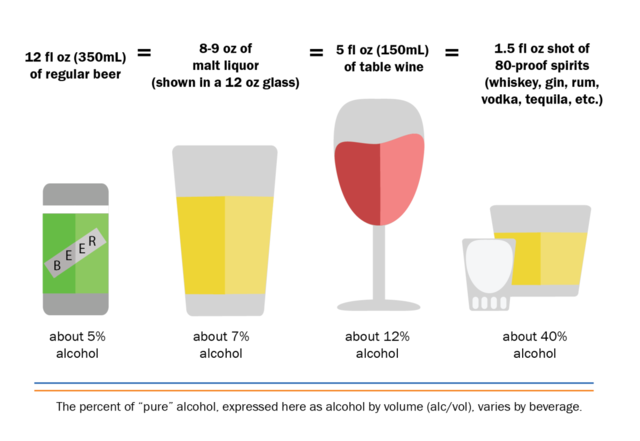 | December 2019
Snapshot
Alcohol and Teens
|
|
|
|
|
Alcohol is one of the oldest and most widely used substances in the world, and is used for religious ceremonies, social occasions, relaxation, self- medication and as a habit.
Beer is the most commonly consumed alcoholic beverage in the world.
Alcohol is absorbed into the bloodstream through the stomach and small intestine; it travels through the body to the brain, where is slows down the activity between nerve cells, operating as a depressant.
|
|
|
 | Alcohol is classified as a neurotoxin psychoactive drug.
The effect alcohol has on a person depends on their size, gender, ethnicity, drinking experience, mood and the environment it is used in.
Studies show that only one drink a day has beneficial effects for adults; these effects have not been shown for youth or children.
|
|
|
In Canada, 90% of adults report drinking alcohol in their lifetime.
Binge drinking is defined as excessive consumption of alcohol (4 or 5 drinks, or more) in a short period of time.
Alcohol consumption in North Africa and the Middle East is close to zero, and is highest in Europe with close to 95% of adults reporting alcohol consumption in the past year.
Within Canada, 70% of youth ages 15 – 24 reported using alcohol in the last year, and 20% of those youth exceeded the Low Risk Alcohol Drinking Guidelines published by Canada Health.
|
|
|

|
Canada Health's Low-Risk Drinking Guidelines:
If you are 19 or older, females should drink no more than 2 drinks a day or 10 drinks a week, and males should drink no more than 3 drinks a day or 15 drinks a week.
If you are under 19, the commendation is to not drink. For young people who do drink, they should consume no more than 1 or 2 drinks in any setting, no more than twice a week.
|
|
|
Guidelines for a “standard drink”
Beer ....................................................................
Hard Liquor...........................................................
Sherry or Port...........................................................
Wine ......................................................................... |
350ml can/bottle at 5% alcohol
45ml/1.5 oz shot at 40% alcohol
95ml/3.5oz glass at 18% alcohol
250ml/5 oz glass at 12 % alcohol (a 750 ml bottle = 5 drinks)
|
|
|
|
|
SHORT TERM EFFECTS (may include some or all):
- Relaxed, or drowsy
- Dizzy
- Depressed or aggressive
- Difficulty with coordination and balance and slowed reaction time
- Poorer Judgement
- Less Inhibited
- Hangover (beginning 8–12 hours after drinking stops) including headache, shakiness, possible short term memory loss
- Alcohol poisoning or overdose
|
|
|
LONG TERM EFFECTS (may include some or all):
- Damage to liver, heart and brain
- Diseases of the stomach, pancreas, mouth, throat or esophagus
- High blood pressure
- Low red blood count (anemia)
- Weaker immune system
|
|
|

|
RISK FACTORS FOR PROBLEMATIC
ALCOHOL USE:
1. Family members with substance use problems in past or present
2. Difficulties dealing with stress and other challenges
3. Family conflict
4. Mental or physical health challenges that are not well managed
5. Difficulty fitting in at school, work or with peers
6. Stressful life changes
7. Trauma
|
|
|
 |
SYMPTOMS OF ALCOHOL POISONING (CALL 911 IMMEDIATELY):
> Severe confusion
> Vomiting and/or seizures
> Blue colour to skin
> Passing out repeatedly
> Decrease in body temperature
> Potential death due to slowed or stopped breathing or choking to death on vomit
|
|
|
|
|

| A parent or guardian of a minor may provide alcohol only to their child in their home.
This exception does not allow for alcohol to be provided to any other minors who may be in the home.
If alcohol is served at a party, a host could be accountable for any harm guests may experience after leaving the premises (even when the guests are of legal age to drink).
|
|
|
|
|
|
|
|

| GENERAL HARM REDUCTION STRATEGIES
1. Avoid, Delay, Reduce Use
2. Don‘t Use Alone
3. Carry Naloxone, if around
Opioids:
Toward the Heart
|
| |
|
|
|
The Greater Victoria School District is committed to providing safe and healthy learning environments for all students. As part of our approach, we have been focusing on mental health and substance use topics to help us promote well-being in our schools.
Substance use is a complex topic that often highlights varied philosophies, myths, and a great deal of fear.
|
The research shows us that early interventions, particularly around critical thinking and decision making, has an impact on delaying use in youth. As well, open dialogue with adults, intentionality around attachment, and a focus on the factors that contribute to substance use, as opposed to the actual substances, also prevent, delay and reduce substance use in our students.
|
Our goal is to create a more cohesive, systematized substance use plan focusing on social emotional learning, that includes our youth and schools, community partners, and families. We strive for a shared vision, common language and consistent messaging over time, in order to support positive youth culture and a healthy perspective on substance use and mental health.
|
|
|
The legal age in B.C for consumption of alcohol and cannabis is 19 years old.
|
|
|
|
|